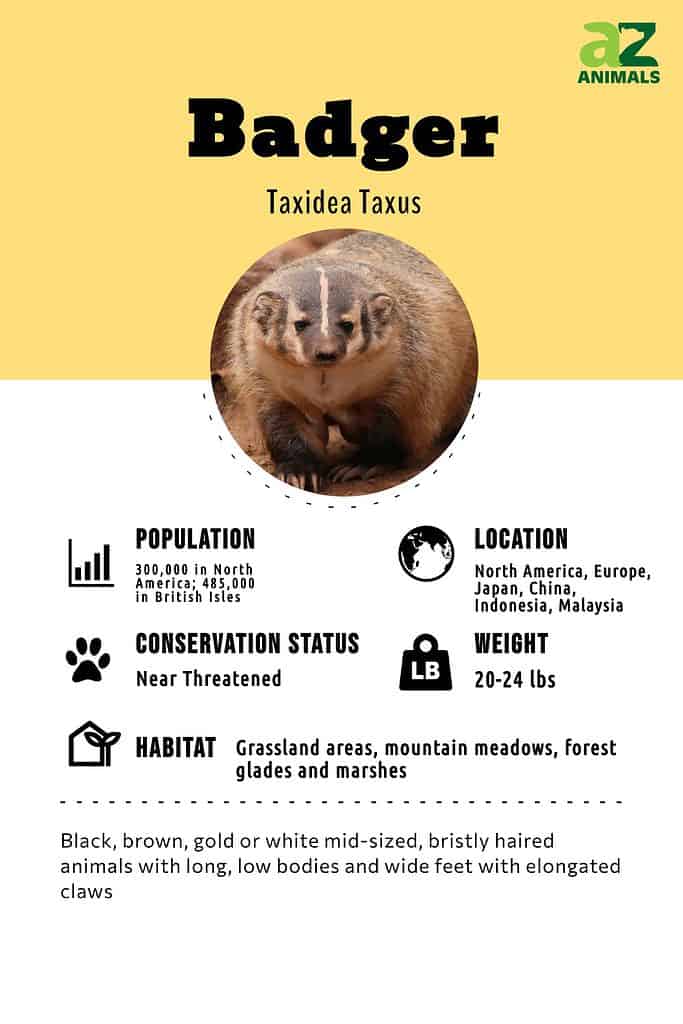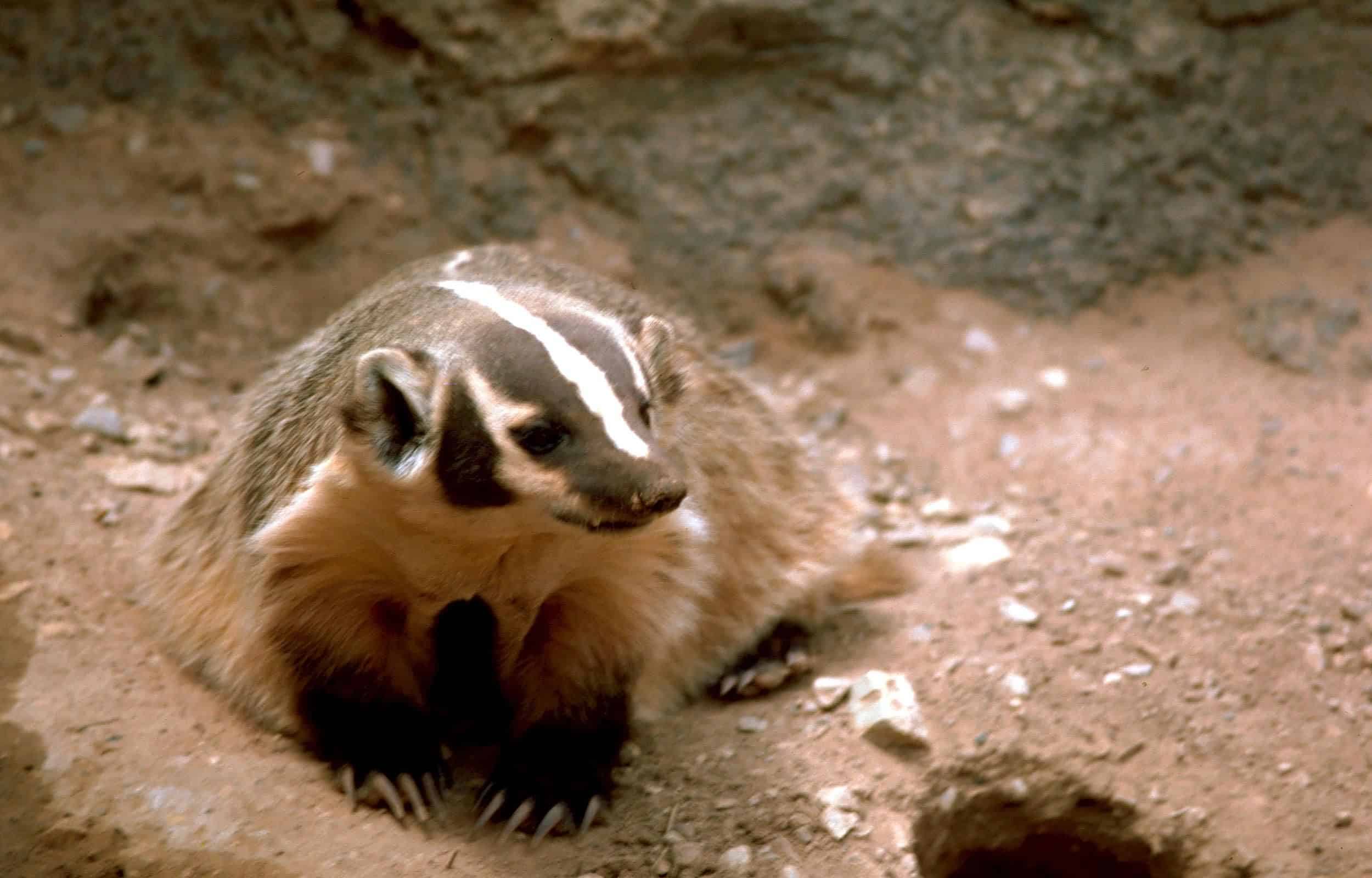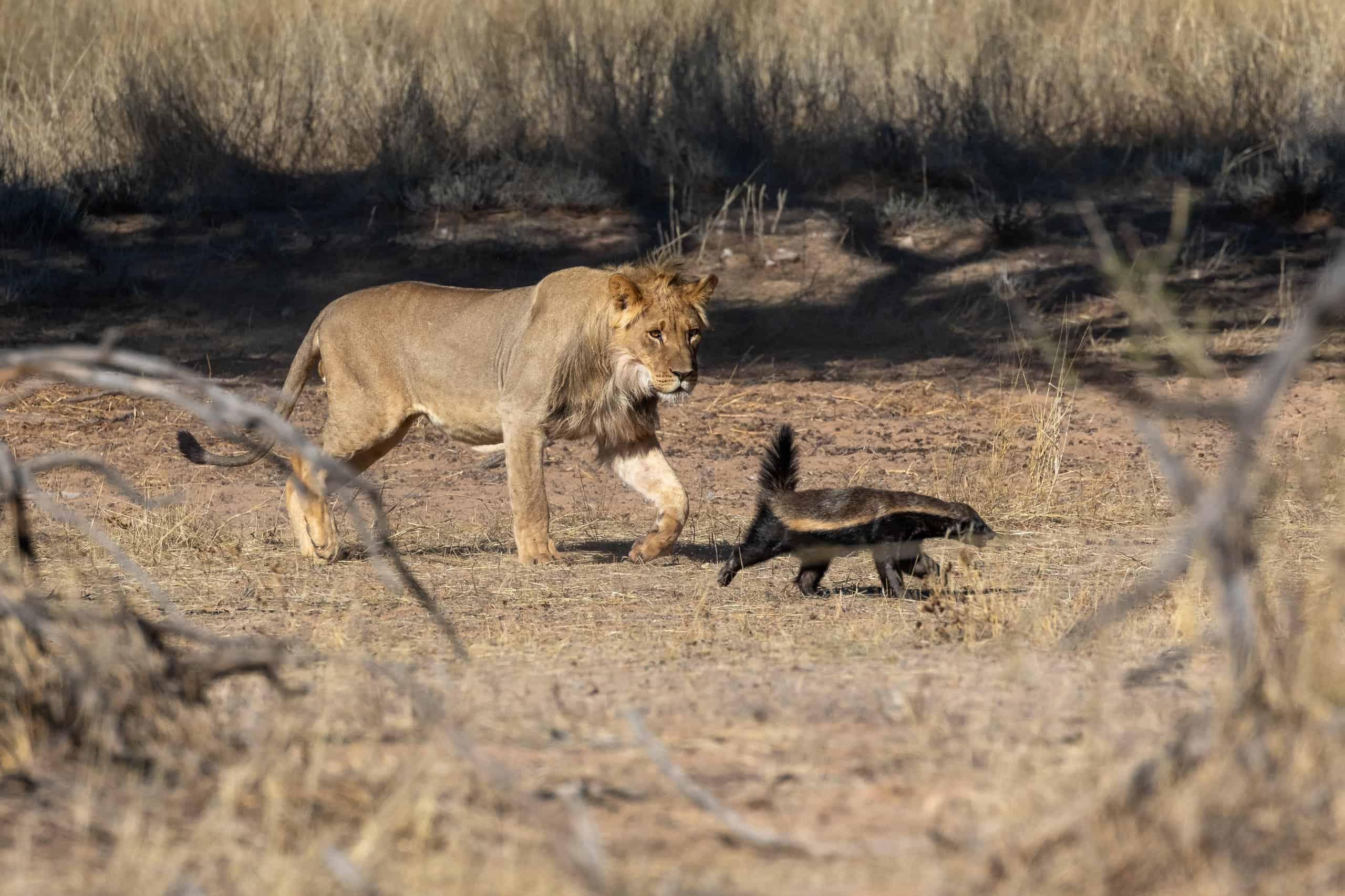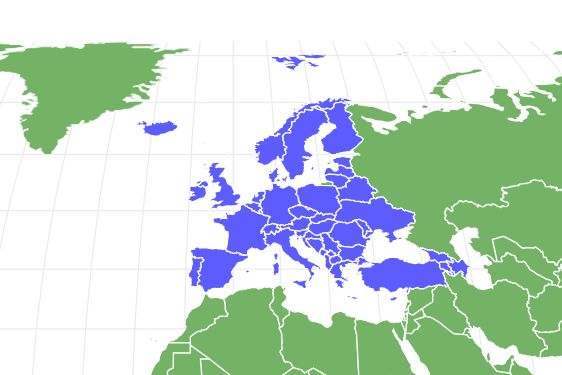Can reach speeds of 30 km/h!
Advertisement
Badger Scientific Classification
- Kingdom
- Animalia
- Phylum
- Chordata
- Class
- Mammalia
- Order
- Carnivora
- Family
- Mustelidae
- Genus
- Taxidiinae
- Scientific Name
- Taxidea Taxus
Read our Complete Guide to Classification of Animals.
Badger Conservation Status
Badger Facts
- Main Prey
- Worms, Rodents, Roots, Fruit
- Distinctive Feature
- Flattened body and long claws
- Habitat
- Woodlands, grasslands, marshes, and brushes
- Predators
- Humans, Golden Eagles, Cougars, Bobcats, Wolves, Bears
- Diet
- Omnivore
View all of the Badger images!
Badgers are especially clean animals that build communal toilets away from where they live and sleep.
Badgers are medium-sized animals with long, low bodies and wide feet that have elongated claws. The badger animals have bristly hair that ranges in color from black to brown as well as gold and even white. Badgers are related to otters, ferrets, wolverines, minks, and weasels. The mammals are nocturnal, and while many of them are social, some may be loners. The badger is Wisconsin’s state animal.

5 Badger Facts
• Badgers are animals that sleep during the day
• There are 11 different badger species
• Young badger animals leave the burrow when they are around 6 months old
• Badgers are a part of the weasel family
• Badgers have few natural predators
You can check out more incredible facts about badgers.
Scientific Name
The scientific name for the badger is Taxidea Taxus, and it is included in the Mustelidae family and is of the Mammalia class. The subfamilies of the badger are Helictidinae, Melinae, Mellivorinae, and Taxideinae. Researchers have classified 11 badger species that are grouped into three types. These are the Melinae, or Eurasian badgers, Mellivorinae, or honey badger, and Taxideinae, or American badgers.
The name “badger” comes from the 16th-century word “bageard.” Originally, the name referred to the European badger, an animal with a white mark on its forehead. Bauson is an outdated name for the badger animal. Brock is another old name for the animal species, but it’s hardly ever used.
Badgers have had several starring roles in British literature throughout the years. For instance, author Kenneth Grahame included a character by the name of “Mr. Badger” in “The Wind in the Willows.” C.S. Lewis added one in the “Chronicles of Narnia” and Beatrix Potter featured a badger by the name of “Tommy Brock” in her book “The Tale of Mr. Tod.”
Types of Badger Species
There are 11 different species of badger found around the world, which include the following:
- American Badger – American badgers are located in most of the United States, northern Mexico, south-central Canada, and southwestern British Columbia. They have a typical badger appearance with distinctive head markings and huge claws. They prefer prairie regions.
- Honey Badger – Honey badgers are found in Africa, Asia, and the Indian subcontinent. They resemble weasels, and are expert at escaping predators with very loose, thick skin. Their preferred habitat is dry areas, grasslands, and forests.
- European Badger – European badgers are located throughout Europe, commonly found in woodlands and suburban parks. They have black and white fur with a smooth coat, and clear and straight lines on their face and around the eyes.
- Greater Hog Badger – The greater hog badger is native to Southeast Asia. It’s known as one of the largest terrestrial mustelids, and lives in tropical evergreen forests and grasslands.
- Japanese Badger – Endemic to Japan, the Japanese badger is smaller than the European badger with long gray-brown hair on the upper coat, and short, black hair underneath. Its face has characteristic black-white stripes. They are found in woodlands and forest habitats.
- Chinese Ferret Badger – Chinese ferret badgers inhabit Southeast Asia, Northeast India, and Central China. They sport distinctive mask-like facial markings that differ from most other species of badger, and are found in grasslands, open forests, and tropical rainforests.
- Asian Badger – Asian badgers are native to native to Mongolia, China, Kazakhstan, Kyrgyzstan, Korea and Russia. Their coloring is lighter than the European badger, with brown facial stripes. Habitats include woodlands, pastures, scrubs, steppes, and high mountain elevations.
- Bornean Ferret Badger – The Bornean ferret badger is a small nocturnal badger only found on the island of Borneo. It’s listed as threatened due to small area of distribution, habitat destruction, and natural disasters. Its most distinguishing feature is a ferret-like facial mask.
- Javan Ferret Badger – Javan ferret badgers are native to Java and Bali, Indonesia, in hilly and mountainous areas, and also lower areas in forests and rubber plantations. They have small heads narrow, blunt snouts, large eyes, and brown silky fur with red, grey, or tawny highlights.
- Burmese Ferret Badger – The Burmese ferret badger resides in Southeast Asia. Its fur can be varied shades of brown, and it sports a white dorsal stripe. The face is marked with black and white patches. Its is nocturnal and lives in grasslands and forests.
- Vietnam Ferret Badger – In 2006, the Vietnam ferret badger was named as its own species due to two dead ones found over two years time that had dark brown heads and bodies with black and white stripes running from their necks to shoulders. Their skulls were also shaped differently.
Appearance and Behavior

The North American badger features short, stubby legs, a muscular body, and a short neck. The animal’s head is wide and flat. Badgers also have a tail. They tend to have gray-colored coats, darker faces, and a white stripe that runs from their backs to their noses. The animal type measures about 9 inches high and is from around 16 inches to 29 inches long. A badger’s tail will vary in size from about 4 inches to 6 inches long or around one-third of the size of the actor Danny DeVito. They weigh from 20 pounds to 24 pounds. The lower jaw of the badger is pronounced from its upper jaw. This means that it’s impossible to dislocate the animal’s jaw, allowing it to maintain a solid hold on its prey. However, the jaw positioning limits movement. A badger can open and shut its mouth or shift it from side to side.
Badger animals are mainly nocturnal, and they spend most of their time underground in the winter. During this time, they fast. To survive long periods without eating, the animal builds up a good deal of fat late in the summer and toward the fall.
Each badger family tends to behave uniquely, but all types of badgers live underground. Some live together in clans known as cete. These vary in size from two animals to as many as 15. Badgers have the capacity to run at speeds of 16 miles per hour to 19 miles per hour for short spurts. The animals are good climbers, and they can swim.
Badgers are animals that are famous for their ferocity. If a female adult badger has babies to protect, then she’ll guard them aggressively. There are accounts of badgers fighting off packs of dogs and attacking much larger animals than themselves like bears and wolves. Badgers may show aggression toward humans if they feel threatened. The animal can deliver a painful bite to protect itself.
The animal species is territorial, and they’ll protect territories that measure around 3 to 4 square miles. The size of a badger’s territory generally depends on how plentiful the food is. Badgers are extremely clean animals that do not defecate in their burrows. In fact, they build shallow pits away from their home for this purpose. Badgers don’t bring food into their burrows either.
Evolution and History
The origins of badgers on the evolutionary chain are a bit sketchy. As they are members of the weasel family, one could trace back the evolution of the weasel and perhaps find more definitive information. For our intents and purposes, there some fossil findings that seem to be ancestors of the honey badger. One fossil, identified as Millivora sivalensis, was an animal similar to the honey badger that is traced to Pakistan at the beginning of the Ice Age 2 million years ago. Another, Benfield’s honey badger, or Mellivora benfieldi has fossils from Italy, Ethiopia, and South Africa. It is thought to have lived 5-6 million years ago during the Late Miocene Period. Definitive honey badger fossils were found in a site near Cape Town, South Africa along with sabretooth tigers and other animals.
Benfield’s honey badger is very similar to the modern honey badger, so is thought to be its ancestor, but this is not certain. Analysis shows this ancestor was smaller, and not as good at digging as the modern badger. Their diets would have been similar, but Benfield’s honey badger may have been more of a meat eater than a root and bulb eater.
The oldest honey badger could be the Howellictis valentini, a 7 million-year-old fossil from Chad. This fossil shows that this badger walked flat-footed like modern badgers, but also was not a good digger. This provides evidence that honey badgers were a distinct group since the Late Miocene.
The genera Eomellivora and Ekorus are thought to be early honey badgers, and are nicknamed “giant honey badgers” for their much larger size. The Eomellivora date back 10 million years and were found in Africa, Eurasia, and even North America.
Habitat

Badgers can be found in mountain meadows, grasslands, forest glades and marshes.
©Coatesy/Shutterstock.com
American badgers generally live in grassland areas as well as in open fields that feature grassland characteristics. They live in parks, on farms, and in spaces that are free of trees. Badgers make their homes in areas that include a healthy rodent supply. You might come across them in mountain meadows, forest glades, and marshes. They’ve also been found in hot desert environments and brushy areas. People have run into badgers at elevations that are as high as 12,000 feet, but the animal prefers to live at lower elevations.
In California, badgers live in agricultural areas and open spaces. They also make their homes in regional, state, and national parks. Badgers that live in Arizona usually live in the semi-desert grasslands and scrub areas. In Ontario, they live on the province’s far southwestern side.
The badger animal’s use of a home area depends upon the season and whether it’s a male or a female badger. The creatures use some areas of their home range more often based on the different seasons. The areas that they use are also based on the prey that they have available. Male badgers usually have larger home spaces than female badgers.
The animal species needs shelter for sleeping, protection from the elements, concealment, and birthing. Badgers frequently increase the size of a gopher hole or a burrow made by another animal for their own use. When a badger builds or appropriates another animal’s burrow, it may be called a sett. The animal’s dens vary in size from around 4 feet to 10 feet deep and 4 feet to 6 feet wide. Female badgers may form two to four burrows close to a connecting tunnel for shelter and protection for their babies. A common sign of a badger den is evacuated soil at the front of the burrow entrance. If you were to look at it from a distance, you would see a mound-like burrow roof with the living space below.
In the summer and fall, badgers range more often. Also, according to burrowing patterns, the animals may dig anywhere from one to three burrows out of prey holes each day. Badgers will use these for a day to a week before abandoning them temporarily and returning to them later. Other wildlife may take advantage of these empty badger burrows. If the prey is abundant, then badgers will reuse burrows, especially during the fall. Sometimes, the animals remain in these dens for several days. When winter arrives, badgers will hole up in a burrow for the majority of the season.
Badgers have different types of sets. However, their main one is the largest. These can be several hundred years old. They can also have a few hundred entrances.
Diet

Badgers are omnivores that prey mainly on pocket gophers, prairie dogs, ground squirrels, and moles. They also eat deer mice and voles along with snakes. The American badger is a major predator of snakes and will even go after rattlesnakes. Badgers may also dine on ground-nesting birds like the bank swallow or the sand martin. They’ll eat lizards, fish, and insects. The animal will eat some plant foods like green beans, corn, mushrooms, and sunflower seeds. Badgers have been known to experience alcohol intoxication from eating rotten fruit.
Predators and Threats
Badgers only have a few natural predators because they are highly aggressive animals. While their predators include coyotes, bobcats, golden eagles, and bears, cougars hunt them the most. Humans trap them for their pelts. Badger fur is used for paintbrushes and shaving brushes.
Humans also hunt them in several countries. The Dachshund dog breed exists because people bred them to hunt badgers. In the past, baiting was popular in England. Fortunately, opposition to the sport led to the passing of the Cruelty to Animals Act of 1835 in addition to the Protection of Badgers Act of 1992. For additional protection, the country passed the Hunting Act of 2004.
In Britain, people ate badgers during World War II. Early American settlers and Native Americans ate them too. Today, European badgers die from starvation and tuberculosis, but more of them are killed by vehicles than by any other way.

A young
lion
stalking a honey badger.
©LouisLotterPhotography/Shutterstock.com
Reproduction, Babies and Lifespan
Mating season is usually in early spring or toward the end of summer. The animals will often mate near the burrows or inside the entrance. Badgers experience delayed implantation. Early embryos implant near the end of December or the first week or two of January. After becoming pregnant, a female badger will dig a natal den, which she’ll use for an extended time. Baby cubs are born after 8 weeks to 10 weeks, and this typically happens in late April or during the first part of May. These cubs feature soft, gray fur, and they are careful and shy. After the babies are born, the female badger may move her litter to look for food in other areas. A natal den will typically be bigger and more intricate than a regular badger den.
Male European badgers are called boars while females are sows. Babies are known as cubs. In North America, baby badgers are called kits. Male and female are the terms used for adult badgers in North America. Female badgers give birth to anywhere from one to five cubs. Female badgers take care of their litter alone, and the babies will stay in the burrow until they are around 8 weeks old. Once baby badgers are around 4 months old, they are able to hunt their own food. At 6 months old, young badgers leave their mother’s burrow.
In the wild, the average lifespan of badgers is from 4 years old to 10 years old. They can live for as long as 14 years. When the animals are in captivity, they can live to be 26 years old.

Most types of badgers are not considered threatened or endangered, but they are highly threatened in
China
, Vietnam, Laos, and Myanmar.
©Martin Mecnarowski/Shutterstock.com
Population
The International Union for Conservation of Nature reports that most types of badgers are not considered threatened or endangered. The population of the American badger is several hundred thousand. However, the hog badger is close to threatened because the animal’s population has declined by just under 30% within three generations. The species is highly threatened in China, Vietnam, Laos and Myanmar. In England and Wales, the population is around 485,000, which means that the species is not in danger there at this time.
More on Badgers
- What Do Badgers Eat? Their Diet Explained
- Badger Teeth: Everything You Need to Know
- Badger Poop: Everything You’ve Ever Wanted to Know
Badger FAQs (Frequently Asked Questions)
Are Badgers Carnivores, Herbivores or Omnivores?
Badgers are omnivores, so they eat both mammals and plants.
Are Badgers Dangerous?
Badger attacks on humans rarely occur, but they happen occasionally. When a person attempts to hold or trap a badger, the animal will defend itself with its claws and teeth. It is a good idea to give a badger plenty of space if you should run into one.
Can Badgers Be Pets?
People have been known to keep badgers as pets. If someone adopts a badger from when it is a baby, then the animal can become acclimated to life as a pet. But, they don’t make the easiest pets. Badgers are natural diggers and can be highly destructive.
Are Badgers Rodents?
Badgers belong to the weasel family, which includes skunks, wolverines and otters. However, they are often mistaken for rodents because of the shape of their bodies and the formation of their heads.
What Kingdom do Badgers belong to?
Badgers belong to the Kingdom Animalia.
What phylum do Badgers belong to?
Badgers belong to the phylum Chordata.
What class do Badgers belong to?
Badgers belong to the class Mammalia.
What family do Badgers belong to?
Badgers belong to the family Mustelidae.
What order do Badgers belong to?
Badgers belong to the order Carnivora.
What genus do Badgers belong to?
Badgers belong to the genus Taxidiinae.
What type of covering do Badgers have?
Badgers are covered in Fur.
In what type of habitat do Badgers live?
Badgers live in woodlands and hedgerows.
What are some distinguishing features of Badgers?
Badgers have flattened bodies and long claws.
What do Badgers eat?
Badgers eat worms, roots, and fruit.
What are some predators of Badgers?
Predators of Badgers include humans, eagles, and wildcats.
What is the average litter size for a Badger?
The average litter size for a Badger is 3.
What is an interesting fact about Badgers?
Badgers can reach speeds of 30 km/h!
What is the scientific name for the Badger?
The scientific name for the Badger is Taxidea Taxus.
What is the lifespan of a Badger?
Badgers can live for 4 to 10 years.
How fast is a Badger?
A Badger can travel at speeds of up to 18 miles per hour.
What is the difference between a skunk and a badger?
One of the easiest ways to tell the difference between badgers and skunks is their size. Badgers are much larger than skunks, averaging between 24-30 lbs. The only time that a skunk and a badger would ever need to be identified by relative size is in North America since it’s the only range that both of them share. The largest species of badger is generally considered to be the European badger. The European badger is commonly used in cartoon descriptions and is often the one that most people are familiar with, although the American badger is a bit smaller and looks similar.
What's the difference between an American badger and a European badger?
The European badger grows larger than the American badger, both in length and weight. The American badger also eats a more carnivorous diet compared to the omnivorous European badger. Finally, these two creatures have different markings as well.
How to say Badger in ...
Thank you for reading! Have some feedback for us? Contact the AZ Animals editorial team.
Sources
- David Burnie, Dorling Kindersley (2011) Animal, The Definitive Visual Guide To The World's Wildlife
- Tom Jackson, Lorenz Books (2007) The World Encyclopedia Of Animals
- David Burnie, Kingfisher (2011) The Kingfisher Animal Encyclopedia
- Richard Mackay, University of California Press (2009) The Atlas Of Endangered Species
- David Burnie, Dorling Kindersley (2008) Illustrated Encyclopedia Of Animals
- Dorling Kindersley (2006) Dorling Kindersley Encyclopedia Of Animals
- David W. Macdonald, Oxford University Press (2010) The Encyclopedia Of Mammals

















